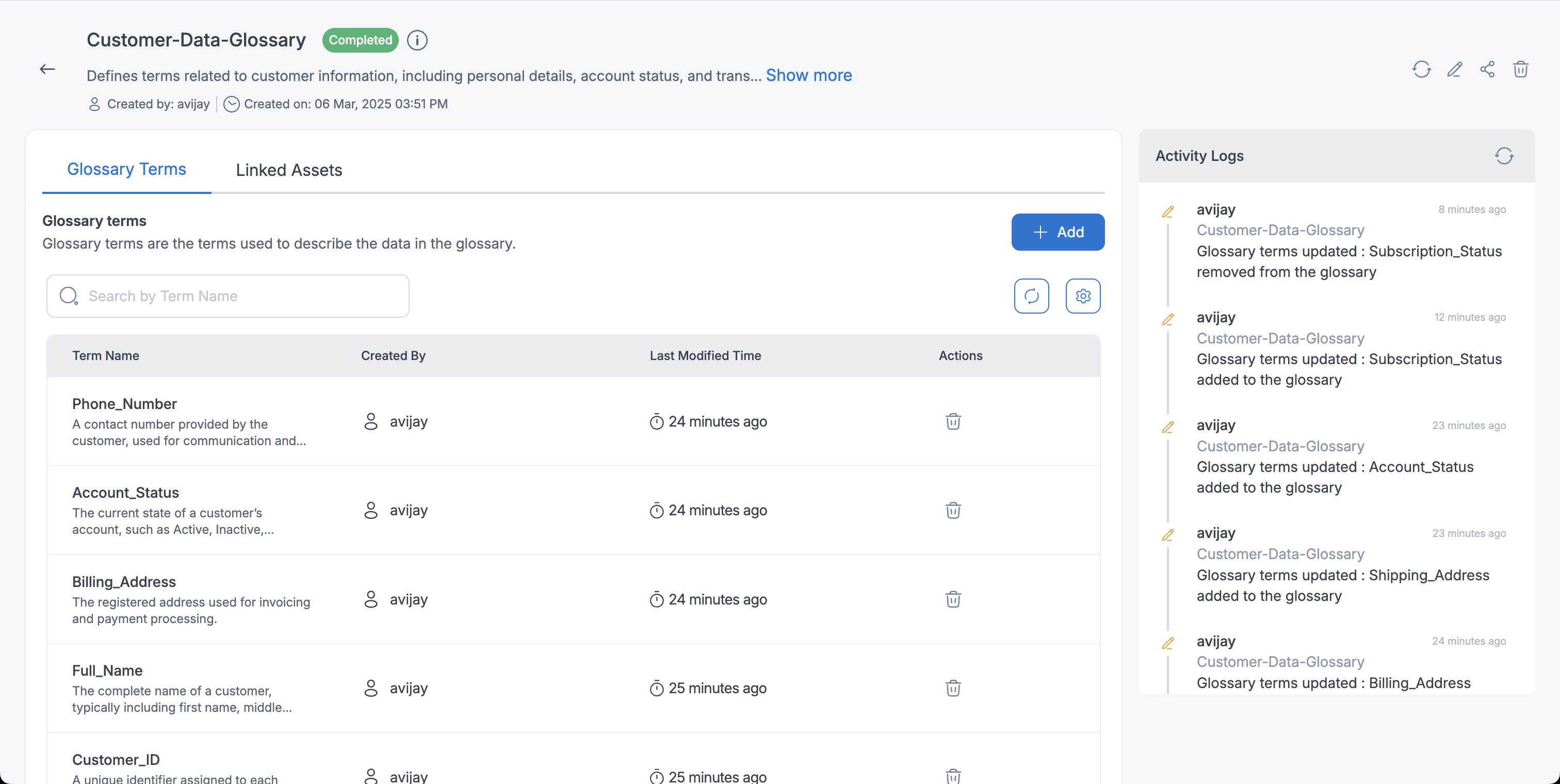Understanding and Managing Glossaries
Overview
Glossaries in Amorphic serve as centralized repositories of standardized terminology and definitions within your organization. They play a crucial role in establishing a common language, reducing ambiguity, and maintaining consistency across teams and departments.
Key Benefits
- Standardized Terminology: Ensure consistent understanding of business terms across your organization
- Enhanced Data Clarity: Link glossary terms to datasets and views for better metadata management
- Improved Communication: Reduce misunderstandings by providing clear, agreed-upon definitions
- Business Ontology: Build relationships between terms to create a comprehensive business vocabulary
- Data Governance: Support compliance and governance initiatives through standardized terminology
- Knowledge Sharing: Facilitate onboarding and cross-team collaboration through shared understanding
- Search & Discovery: Enable quick access to term definitions and related assets
Example Use Cases
Here are some practical examples of how glossaries can be effectively utilized:
-
Healthcare Domain:
- Term: "PRESCRIPTION"
- Definition: A formal instruction from a licensed healthcare provider for medication or treatment
- Related Terms: HOSPITAL_ID, DOCTOR_ID, PATIENT_ID
- Usage Context: EMR systems, pharmacy management, insurance claims
-
Financial Services:
- Term: "CREDIT_SCORE"
- Definition: A numerical assessment of a customer's creditworthiness
- Related Terms: CUSTOMER_ID, PAYMENT_HISTORY, CREDIT_LIMIT
- Usage Context: Risk assessment, loan applications, credit monitoring
-
E-commerce:
- Term: "CUSTOMER_LTV"
- Definition: Predicted total value of a customer's business over the entire relationship
- Related Terms: PURCHASE_HISTORY, CUSTOMER_SEGMENT, RETENTION_RATE
- Usage Context: Marketing analytics, customer segmentation
Accessing Glossaries
Glossaries are accessible through the Discover tab of Amorphic. The glossaries listing page provides a comprehensive view of all available glossaries in your organization, with powerful search and filtering capabilities.

Creating and Managing Glossaries
Creating a New Glossary
Follow these steps to create a new glossary:
- Navigate to the Glossaries listing page
- Click the
+ Create Glossarybutton - Provide the following information:
- Glossary Name: Choose a clear, descriptive name (e.g., "Finance Terms", "Marketing Metrics")
- Description: Write a comprehensive description explaining the glossary's purpose, scope, and intended audience
- Click
Createto finalize

Viewing and Managing Glossary Details
The Glossary details page is organized into several key sections:
-
Metadata Header:
- Glossary name and description
- Creation date and Creater information
- Quick action buttons (Edit, Share, Delete)
-
Activity Logs:
- Real-time tracking of all changes
- User attribution for each action
- Detailed change history
-
Main Content Tabs:
- Terms: Manage glossary terms and definitions
- Linked Assets: View and manage asset associations

Managing Terms
Adding New Terms
To add a new term to your glossary:
- Navigate to the Terms tab
- Click
+ Add - Enter the following information:
- Term Name: The standardized term
- Definition: A clear, comprehensive definition
- Click
Add Termto save

Updating and Deleting Terms
Maintain your glossary by:
- Updating term definitions as they evolve
- Removing obsolete terms
- Refining existing definitions

Discovery and Search
Finding Glossaries and Terms
The Discover page offers powerful search and navigation capabilities:
- Full-text search across all glossaries and terms
- Advanced filtering and sorting options

Linking Glossaries and Assets
Linking Glossary terms and Assets is a powerful feature that allows you to associate specific terms with relevant assets. This helps in maintaining a clear understanding of how terminology is applied across your data landscape.
- Steps involved:
- Navigate to
Catalogunder theDiscovertab - Find and select the Asset you want to link Glossaries to
- Under
Glossariestab, select a column and the glossary term to associate it with - Click
Saveto finalize
- Navigate to

Linked Assets
The Linked Assets tab displays a comprehensive view of how glossary terms are connected to your data assets. You can see which dataset columns are associated with specific terms
This visualization helps you understand how terminology is being used across your data landscape and maintain consistency in your data governance.

Governance and Tracking
Activity Monitoring
Track all glossary-related activities:
- Creation and modification timestamps
- User actions and changes
- Term additions and removals
- Definition updates

Access Control and Sharing
Manage glossary access:
- Share glossaries with specific users
- Set appropriate permission levels
- Control who can view and modify terms

Glossary Deletion
To delete a glossary:
- Navigate to the glossary details page
- Click the delete option
- Confirm the deletion
Deleting a glossary:
- Removes all terms within the glossary
- Disassociates all linked assets and columns
- Cannot be undone

Best Practices
-
Naming Conventions:
- Use clear, consistent naming patterns
- Avoid abbreviations unless widely accepted
- Include business context in names
- Follow organizational standards
-
Definitions:
- Write clear, concise definitions
- Include relevant examples
- Reference related terms
- Provide usage context
- Keep technical jargon minimal
-
Maintenance:
- Regularly review and update terms
- Archive obsolete terms
- Document major changes
-
Organization:
- Group related terms together
- Maintain consistent formatting